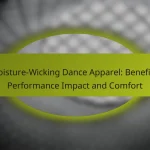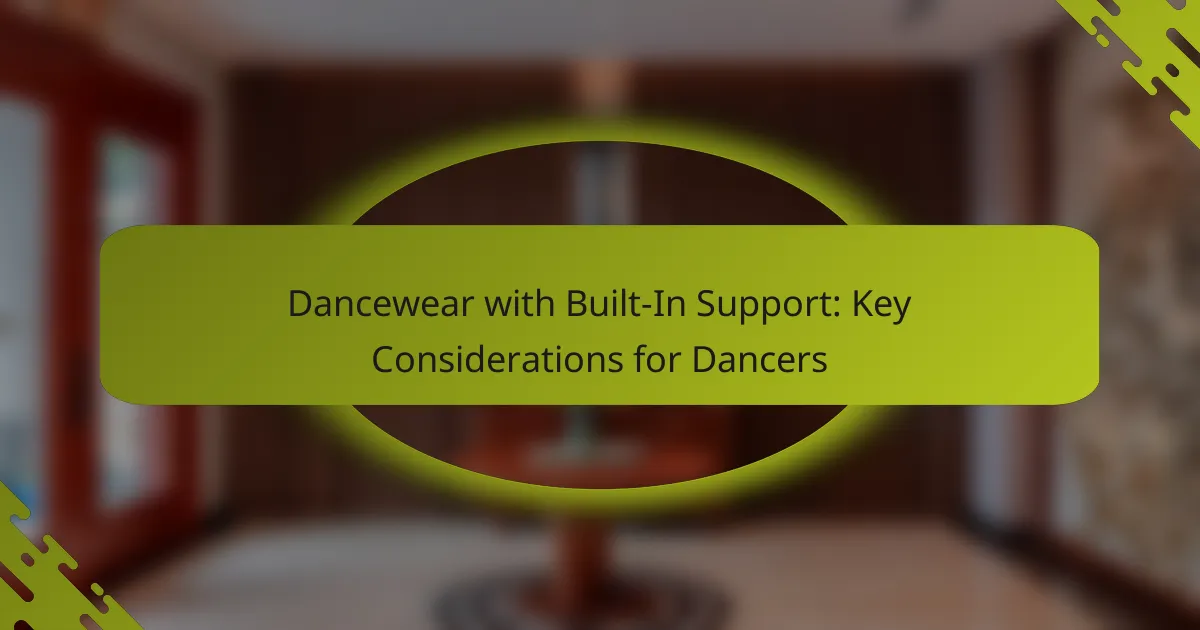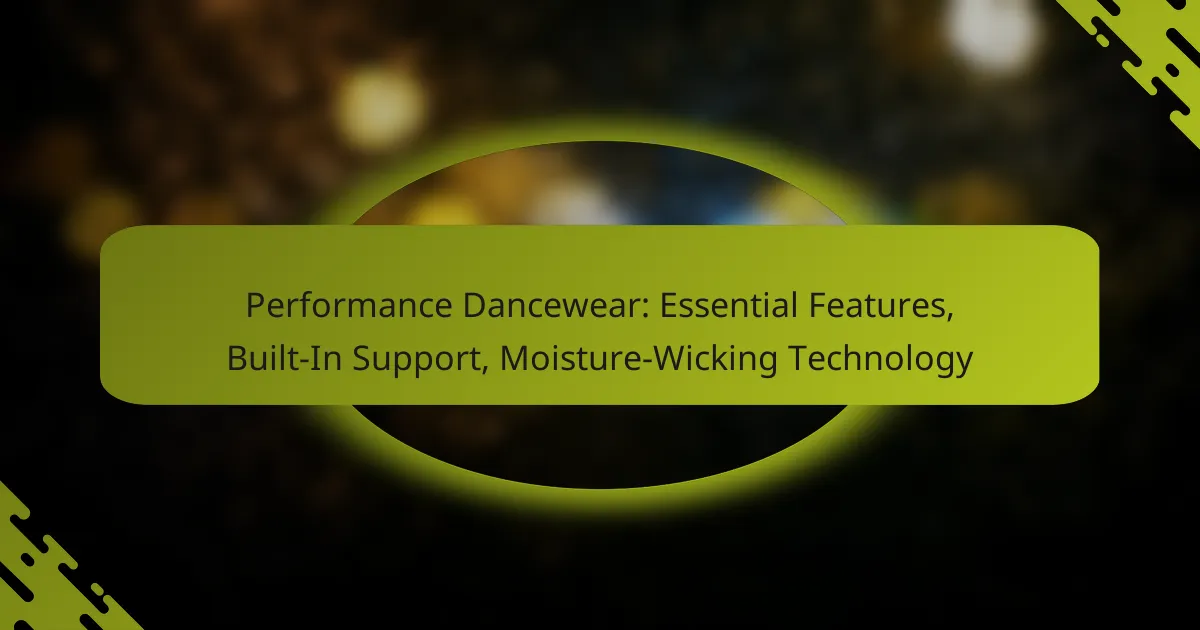Moisture-wicking dance apparel is essential for dancers seeking enhanced comfort and performance. By effectively drawing sweat away from the body, these garments help maintain dryness and regulate temperature, allowing for improved focus during practice and performances. With options from renowned brands like Bloch, Capezio, and Gaynor Minden, dancers can find stylish and functional clothing tailored to their needs.
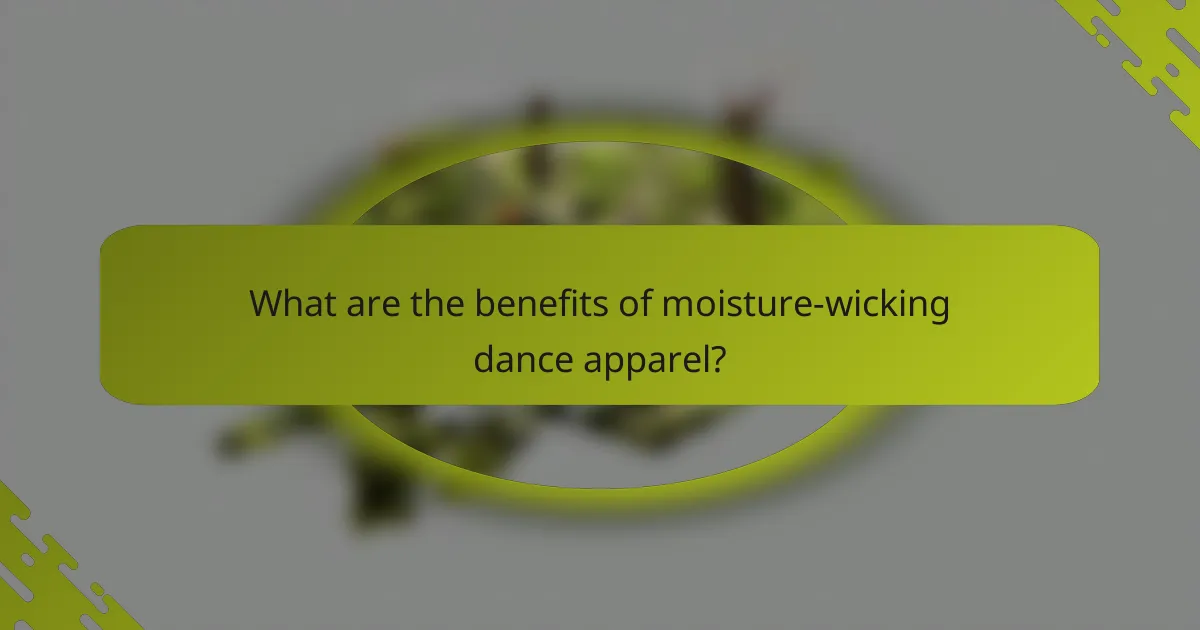
What are the benefits of moisture-wicking dance apparel?
Moisture-wicking dance apparel offers several advantages, including enhanced comfort, better moisture management, and improved performance. These garments are designed to draw sweat away from the body, keeping dancers dry and comfortable during their routines.
Enhanced comfort during performances
Wearing moisture-wicking apparel significantly enhances comfort by preventing the fabric from clinging to the skin. This allows dancers to move freely without the distraction of damp clothing. The lightweight nature of these fabrics also contributes to a more enjoyable experience on stage.
Choosing the right fit is essential; garments should be snug but not restrictive. Look for options that offer a blend of synthetic fibers, which typically provide the best moisture-wicking properties.
Improved moisture management
Moisture management is a key benefit of these specialized fabrics, as they effectively pull sweat away from the skin and allow it to evaporate quickly. This helps maintain a dancer’s focus and performance level, especially during intense routines. Fabrics like polyester and nylon are commonly used for their superior moisture-wicking capabilities.
When selecting apparel, consider the fabric’s moisture-wicking rating. Higher ratings indicate better performance in keeping you dry, which can be crucial for long practice sessions or performances.
Increased durability of fabrics
Moisture-wicking dance apparel is often made from durable materials that withstand frequent washing and wear. This longevity is important for dancers who need reliable clothing that can endure rigorous use. Fabrics designed for moisture management typically resist fading and stretching, maintaining their shape and color over time.
Investing in high-quality moisture-wicking apparel can save money in the long run, as these garments tend to last longer than standard fabrics. Look for brands that offer warranties or guarantees on their products for added peace of mind.
Better temperature regulation
Moisture-wicking fabrics help regulate body temperature by promoting airflow and reducing heat buildup. This is particularly beneficial during high-energy dance routines, where overheating can hinder performance. By keeping the body cooler, dancers can maintain their stamina and focus.
Consider layering moisture-wicking pieces for added temperature control. For example, a moisture-wicking tank top under a lightweight long-sleeve shirt can provide flexibility in varying studio temperatures.
Reduced skin irritation
Wearing moisture-wicking apparel can significantly reduce skin irritation caused by sweat and friction. These fabrics are designed to minimize chafing, making them ideal for dancers who engage in repetitive movements. Smooth seams and soft textures further enhance comfort and reduce the risk of rashes.
When selecting moisture-wicking clothing, pay attention to the construction details. Look for flat seams and tagless designs to further minimize irritation during performances.
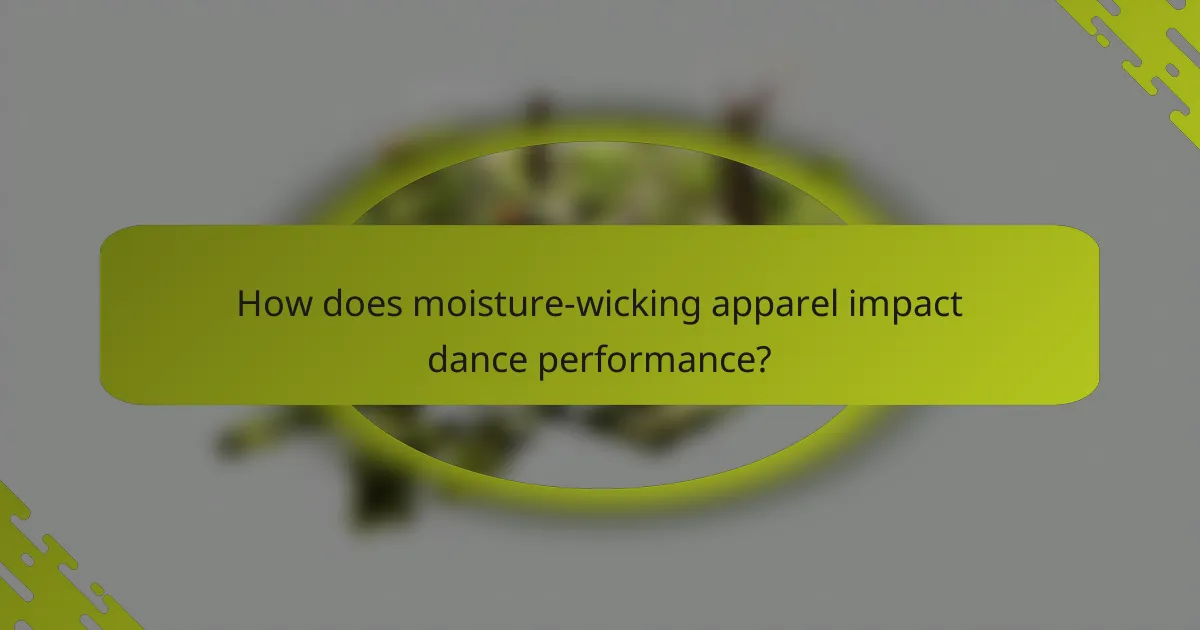
How does moisture-wicking apparel impact dance performance?
Moisture-wicking apparel significantly enhances dance performance by keeping dancers dry and comfortable. This type of clothing draws sweat away from the skin, allowing for better temperature regulation and improved focus during practice and performances.
Improved focus and concentration
Wearing moisture-wicking apparel helps dancers maintain focus by reducing distractions caused by sweat and discomfort. When dancers feel dry and comfortable, they can concentrate more on their movements and routines, leading to better overall performance.
This enhanced focus is particularly beneficial during long rehearsals or performances, where maintaining mental clarity is crucial. Dancers can engage fully with their choreography without the annoyance of damp clothing.
Enhanced movement flexibility
Moisture-wicking fabrics are often designed to be lightweight and stretchy, which promotes greater movement flexibility. This allows dancers to execute a wider range of motions without feeling restricted by their clothing.
For example, fabrics like polyester and nylon are commonly used in moisture-wicking apparel, providing a comfortable fit that moves with the body. This flexibility can be especially important in styles that require intricate footwork or dynamic body movements.
Reduced fatigue during practice
By keeping the body cooler and drier, moisture-wicking apparel can help reduce fatigue during practice sessions. When sweat is effectively managed, dancers can perform longer without experiencing the physical drain that comes from overheating or being weighed down by wet clothing.
Choosing the right moisture-wicking gear can make a noticeable difference in energy levels, allowing dancers to focus on perfecting their skills rather than battling discomfort. Investing in quality apparel can lead to more productive and enjoyable practice sessions.

Which brands offer the best moisture-wicking dance apparel?
Several brands are renowned for their moisture-wicking dance apparel, focusing on performance, comfort, and style. Notable names include Bloch, Capezio, and Gaynor Minden, each offering unique features tailored to dancers’ needs.
Bloch’s moisture-wicking collection
Bloch provides a range of moisture-wicking dance apparel designed to keep dancers dry and comfortable during intense performances. Their fabrics are engineered to draw sweat away from the skin, allowing for better airflow and temperature regulation.
Popular items include leotards and tights that feature advanced moisture management technology. Dancers often appreciate the lightweight feel and flexibility of Bloch’s materials, which enhance movement without sacrificing support.
Capezio’s performance fabrics
Capezio is well-known for its innovative performance fabrics that combine moisture-wicking properties with durability. Their apparel is crafted to withstand rigorous training while effectively managing moisture and odor.
Many dancers favor Capezio’s leggings and tops for their stylish designs and functional features, such as flat seams and breathable mesh panels. These elements contribute to a comfortable fit that supports a full range of motion.
Gaynor Minden’s innovative designs
Gaynor Minden focuses on creating innovative designs that prioritize both aesthetics and functionality in moisture-wicking dance apparel. Their products are made from high-quality materials that not only wick moisture but also provide a flattering fit.
Dancers often highlight the unique construction of Gaynor Minden’s garments, which include features like reinforced stitching and adjustable elements. This attention to detail ensures that dancers can perform confidently while staying dry and comfortable.
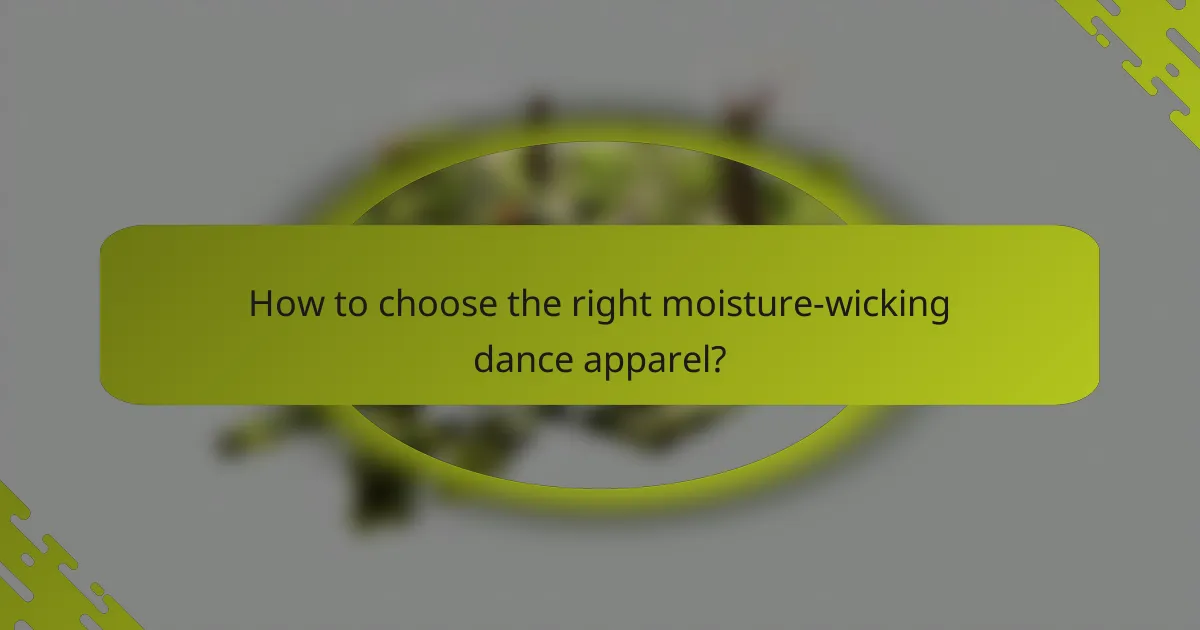
How to choose the right moisture-wicking dance apparel?
Choosing the right moisture-wicking dance apparel involves considering fabric composition, fit, and breathability. These factors ensure comfort and performance during dance activities, allowing for better movement and reduced sweat accumulation.
Consider fabric composition
The fabric composition of moisture-wicking dance apparel plays a crucial role in its effectiveness. Look for materials like polyester, nylon, or blends that are specifically designed to draw moisture away from the skin. Avoid cotton, as it retains moisture and can lead to discomfort.
Additionally, fabrics with antimicrobial properties can help reduce odor, making them ideal for long dance sessions. Check for labels that specify moisture-wicking technology to ensure you are getting the right performance features.
Evaluate fit and sizing
Fit and sizing are essential for optimal performance in moisture-wicking dance apparel. Choose clothing that allows for a full range of motion without being too loose or too tight. A snug fit can help prevent chafing, while overly baggy clothing may hinder movement.
Refer to sizing charts provided by manufacturers, as sizes can vary significantly between brands. When possible, try on different styles to find what feels best for your body type and dance style.
Assess breathability and stretch
Breathability and stretch are key characteristics to look for in moisture-wicking dance apparel. Fabrics that allow air circulation help keep you cool during intense dance sessions. Look for mesh panels or perforated designs that enhance airflow.
Stretch is equally important, as it allows for unrestricted movement. Fabrics with spandex or elastane provide the necessary flexibility for various dance movements. Always test the stretch by moving in the apparel to ensure it meets your performance needs.
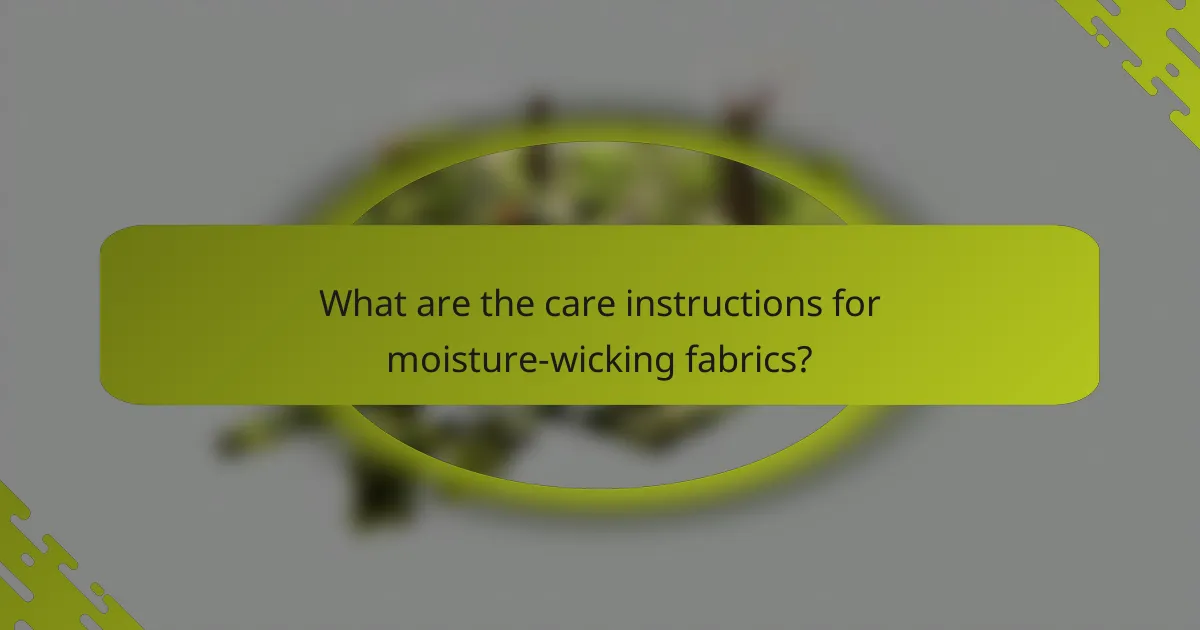
What are the care instructions for moisture-wicking fabrics?
To maintain the performance and longevity of moisture-wicking fabrics, follow specific care instructions. Proper washing and drying techniques help preserve their moisture management properties and overall comfort.
Machine wash in cold water
When washing moisture-wicking apparel, always use cold water. This helps prevent damage to the fabric’s fibers and maintains their moisture-wicking capabilities. Hot water can cause shrinkage and degrade the fabric over time.
For best results, use a gentle cycle to minimize agitation, which can lead to pilling. Avoid mixing these garments with heavy items like towels to reduce friction during the wash.
Avoid fabric softeners
Fabric softeners can leave a coating on moisture-wicking fabrics, which interferes with their ability to wick away sweat. Instead of softeners, consider using a mild detergent specifically designed for athletic wear.
Check labels for “no fabric softeners” recommendations, as this will help maintain the fabric’s breathability and moisture management features.
Air dry for longevity
To extend the life of moisture-wicking apparel, air drying is recommended. Hang the garments in a well-ventilated area away from direct sunlight, which can cause fading and deterioration.
If you must use a dryer, opt for a low heat setting and remove the items while they are still slightly damp to prevent over-drying, which can weaken the fabric. Regular air drying can help retain the fabric’s elasticity and performance.


